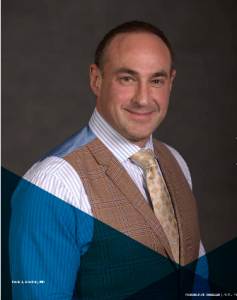
AZ Big Media: Healthcare Business Leaders 2022 – Dr. David Jacofsky
This article originally appeared in AZ Big Media on December 31, 2021
Here is Arizona’s healthcare industry outlook for 2022
 The pandemic impacted the healthcare industry like a teeter-totter stuck on hyperdrive. While many hospitals skyrocketed in capacity, providers in a number of specialties experienced dips and sometimes devastating declines in patient numbers. Then, those who shifted to telemedicine were able to recoup some of their losses. And, the ups-and-downs will likely continue for some time as patients who parlayed routine checkups and health appointments during the pandemic’s peak begin to return. But this is a small sampling of the ways healthcare has been impacted in the last two years and Arizona’s healthcare industry outlook for 2022.
The pandemic impacted the healthcare industry like a teeter-totter stuck on hyperdrive. While many hospitals skyrocketed in capacity, providers in a number of specialties experienced dips and sometimes devastating declines in patient numbers. Then, those who shifted to telemedicine were able to recoup some of their losses. And, the ups-and-downs will likely continue for some time as patients who parlayed routine checkups and health appointments during the pandemic’s peak begin to return. But this is a small sampling of the ways healthcare has been impacted in the last two years and Arizona’s healthcare industry outlook for 2022.
As we look to a new year, will topsy-turvy trends continue within the healthcare sector? To help discover what comes next, we turn to David J. Jacofsky, MD, chairman and chief executive officer of HOPCo (Healthcare Outcomes Performance Company), The CORE Institute, and its affiliated entities. In addition to being fellowship-trained in orthopedic oncology and complex adult reconstruction, Dr. Jacofsky has authored nearly 100 peer- reviewed publications and over 40 book chapters. He is known as a leader in value-based care and for aligning stakeholders in the healthcare industry. To help predict what’s in store for 2022, Dr. Jacofsky starts us off with a macro view of the nation’s healthcare landscape.
A shift in healthcare models
On a national level, Dr. Jacofsky anticipates increased consolidation of physician groups. “Expansion and momentum in value-based care are driving the need for investments that traditional practices will likely find untenable to make on their own,” he says. “Further, COVID had significant impacts on many smaller practices and some have come to realize that they may lack the infrastructure and business leadership that they ideally need.”
One of the most prominent impacts spurring consolidation undoubtedly results from the great resignation. Research reflects that of resignations, 3.6% more health care employees resigned from their jobs than in the previous year. And, while this may not seem significant, when coupled with the data reflecting that 4 million Americans quit their jobs in July 2021, that 3.6% becomes more significant.
Another country-wide projection demonstrates the likelihood for a prominent consumer shift to less traditional, more affordable care models. Clinics and practices that offer concierge and membership options with lower fees are–and will likely continue to be–increasingly more desirable to patient populations seeking to save money.
“Longer term,” Jacofsky explains, “The continued shift from volume-based to value-based reimbursement will further pressure smaller groups in many markets.”
By remaining focused on growing their platform to provide evidence-based, value-based care for a growing number of patients, HOPCo’s success has been largely unencumbered by the pandemic. In fact, according to Dr. Jacofsky, announcements related to growth in value-based care in a number of states are forthcoming and will likely grow the HOPCo platform beyond the 31 states it currently operates in.
The great rebound
While Arizona will experience some of the same trends as the rest of the nation in 2022–and beyond–there are unique emerging healthcare trends particular to regional demographics.
“COVID-19 had a significant impact on Arizona–both due to surges–and the generally older population in the state as compared to others,” Jacofsky says.
In turn, this influx has led to a backlog in medical procedures, as well as delayed diagnosis of conditions that are often harder to treat with delayed diagnosis. “I expect to see a rebound in orthopedic surgical volumes as hospital capacity and patient comfort levels normalize,” Jacofsky adds.
Despite the hardships brought on by the pandemic, Arizona’s health sector has been remarkably resilient. This is largely in part to a solid and growing statewide infrastructure paired with unprecedented collaboration amongst health-related businesses of all shapes and sizes.
“While many other practices were shuttering,” Jacofsky says, “we helped our partners convert their existing clinic locations to urgent orthopedic care centers. We also enhanced and augmented our telehealth platform that allowed thousands of patients to receive high level care without having to go to a physical office.”
HOPCo’s high-level goal during the pandemic was to ease the burdens on both local and national hospitals and emergency departments to enable their colleagues to care for COVID-19 patients–something Dr. Jacofsky explains was well received by HOPCo’s hospital partners and patients throughout the country.
A focus in preventive care
Perhaps one of the top overarching trends to come: An emphasis in preventive care. Early studies demonstrate how the pandemic has raised health consciousness among Americans. According to the Vida Health virtual care program, a survey of more than 10,000 users reflected that people have upped their daily exercise minutes by 43%, with 49% more individuals increasing logging daily food intake, and a 53% increase in users seeking support from licensed therapists and coaches.
Dr. Jacofsky anticipates the trend of health consciousness to extend to businesses. “I believe the pandemic will further reinforce the role of employers and healthcare providers in keeping people healthy,” he says. “Investments into wellness, whether related to government grant spending on preventative care, or by physicians working to drive real value in the services they provide, will continue to be front and center.”